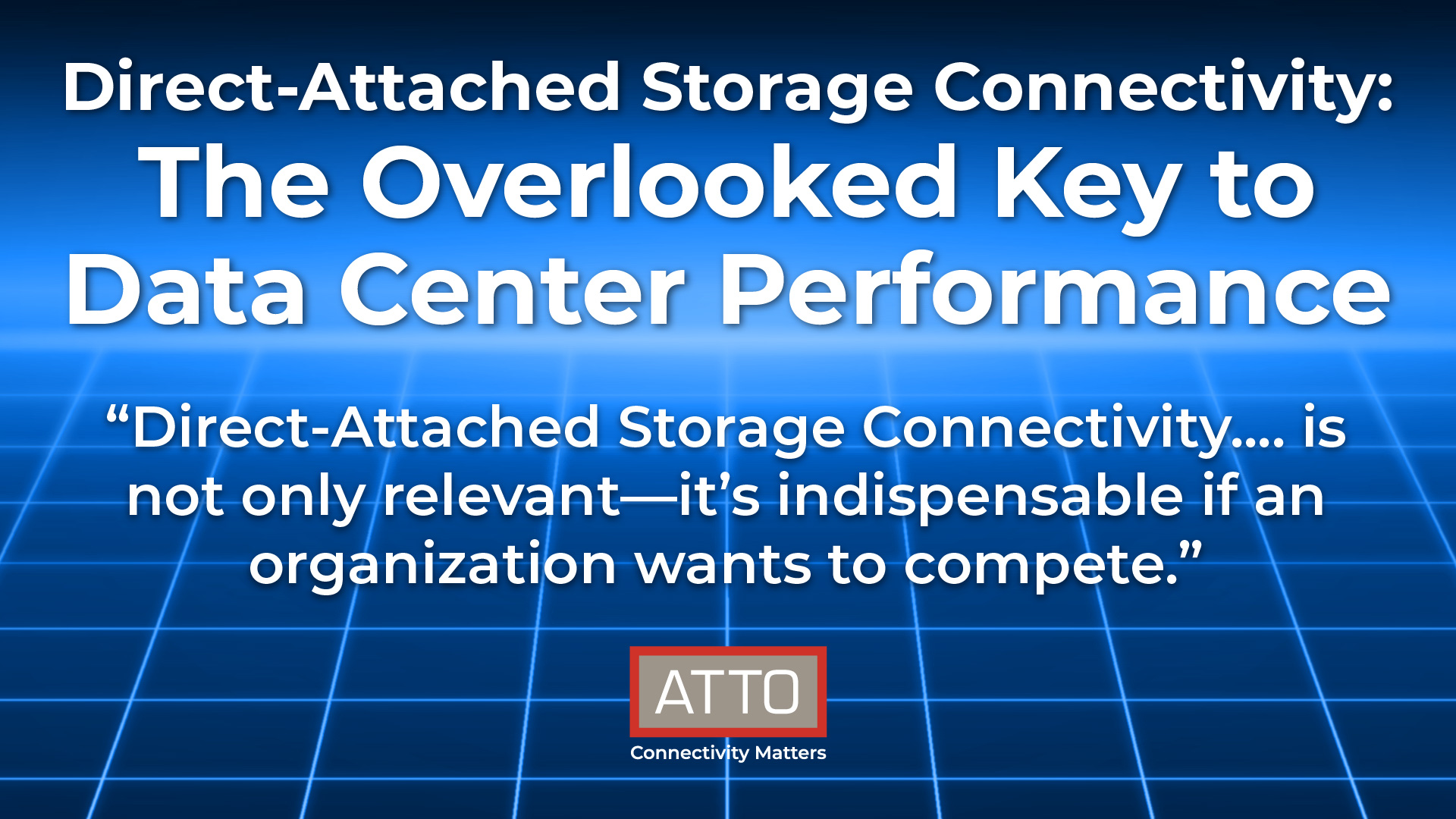
Direct-Attached Storage Connectivity: The Overlooked Key to Data Center Performance
In today’s data-intensive environments, server and storage hardware continue to evolve rapidly—but performance bottlenecks often persist. Why? Because storage connectivity is too often treated as an afterthought. While CPUs and storage get the spotlight, the path that data travels between them plays an equally critical role. Direct-Attached Storage (DAS), when paired with high-performance, purpose-built connectivity, enables data centers to fully unlock the capabilities of modern storage architectures.
Direct-Attached Storage requires dedicated pipelines between servers and storage, supporting critical tasks like database transactions, high-throughput analytics, and virtualization. Yet many data centers rely on commodity or integrated connectivity solutions that limit speed and scalability. Only purpose-built connectivity hardware delivers the low-latency, high-performance access needed for modern workloads.
The Strategic Role of Direct-Attached Storage Connectivity in Modern IT Infrastructure
The global datasphere reached approximately 149 zettabytes in 2024, with projections estimating 181 zettabytes by 2025 (Statista, “Volume of Data Created Worldwide”, May 31, 2024). Organizations need infrastructure supporting high-speed, direct data access. Unlike shared network storage, Direct-Attached Storage provides this through dedicated server-storage paths which can be optimized for exceptional performance.
However, commodity connectivity solutions introduce delays, limiting performance for mission-critical tasks. In contrast, purpose-built connectivity hardware ensures ultra-fast access to Direct-Attached Storage with minimal latency, ideal for structured data (e.g., customer records) and unstructured data (e.g., video or imaging).
Understanding the Storage Landscape: HDDs, SSDs, and NVMe
Traditional Hard Disk Drives (HDDs) remain relevant for cold storage and backups, but their role in performance-tier server workloads has declined. SSDs, using Serial ATA (SATA) or Serial Attached SCSI (SAS), offer improved speed and durability over HDDs (Western Digital, “HDD vs. SSD: What’s the Difference?”, October 2023).
NVMe SSDs, interfacing directly with the server’s PCIe bus, eliminate legacy protocol layers, delivering significantly lower latency and higher IOPS than SATA/SAS SSDs (AnandTech, “An Introduction to NVMe”, May 21, 2015). However, just like SAS/SATA, NVMe performance is only as good as its connectivity; if the path isn’t optimized, storage performance will never reach its full potential.
These storage media, including tape, are strategically deployed based on their strengths: tape for archiving, HDDs for cold storage, SSDs for active data, and NVMe SSDs for near-instantaneous data access and ultra-low-latency workloads. They are commonly integrated into organizational infrastructure.
Connectivity Makes the Difference
As noted, even high-performance NVMe drives underperform with suboptimal connectivity. This is because generic Host Bus Adapters (HBAs), do-it-all NVMe adapters, and built-in motherboard ports lack enterprise-grade throughput, thermal resilience, or signal integrity (TechTarget, “What is a Host Bus Adapter?”, November 2021).
Purpose-built Direct-Attached Storage connectivity solutions, such as those from ATTO Technology, maximize bandwidth, minimize latency, and ensure stability under sustained loads. Features like error handling, signal conditioning, and integrated management software enhance performance for data-intensive tasks like analytics and virtualization, unlike commodity solutions which are basic designs with minimal features, bare-bones support and very limited flexibility.
Scaling Without Compromise
Scalability should mean adding capacity without sacrificing performance. Direct-Attached Storage uses dedicated storage paths to each server, minimizing contention compared to shared infrastructure. The scalability of commodity connectivity, however, can be questionable, quickly reaching limits in performance and stability.
Environments architected with purpose-built Direct-Attached Storage connectivity enable organizations to add SSDs or HDDs while maintaining fast, consistent access speeds (TechTarget, “What is Direct-Attached Storage?”, January 2022). High-performance connectivity supports features like multi-path redundancy, hot-swapping, and intelligent load balancing, ensuring enterprise-grade agility and scalability for growing data workloads.
Simplified Management and First-Tier Support
Purpose-made Direct-Attached Storage connectivity delivers more than speed—it provides robust management tools for deployment, monitoring, and maintenance. Unlike commodity solutions, which lack advanced management, specialized hardware provides intuitive configuration software, diagnostics, and monitoring dashboards.
These tools empower in-house IT teams to manage storage connectivity more effectively, reducing reliance on external support. Many enterprise-grade solutions even offer firmware-level features that enable predictive failure alerts or self-healing capabilities.
A Smarter Investment in Storage Infrastructure
Commodity connectivity solutions may seem cost-effective, but they often lead to downtime, inefficiencies, and added hardware costs to meet performance needs. Conversely, high-performance Direct-Attached Storage connectivity maximizes ROI by delivering fast, reliable performance.
From SSDs and HDDs to NVMe drives, storage media will only achieve optimal performance when the connectivity is purpose-made to achieve optimal performance. To achieve the highest-level performance, the connectivity provider will optimize its solution for specific drives, JBODs, JBOFs, servers and even use-cases. Advanced hardware, combined with intelligent software, enables scalable, efficient infrastructure for workloads including AI, analytics, virtualization, big data, and, in the near future, quantum computing.
The Future Is Direct, Fast, and Scalable
Data centers face real-time demands and exponential data growth, making infrastructure choices critical in big data, AI enhanced world. With AI and other, more data and processor hungry applications growing like never before, the choice of architecture components is more important than ever. Connectivity purpose-made for these environments and workflows is not only relevant—it’s indispensable if an organization wants to compete.
Unlike commodity or integrated solutions, which limit speed, stifle scalability, and lack advanced features with minimal support, purpose-made high-performance connectivity optimizes data transfer between CPUs, GPUs, and storage for fast, scalable, and manageable architectures. Prioritizing robust connectivity enhances the entire storage stack, enabling organizations to focus on their core objectives and achieve a strong ROI.
ATTO Technology High-Performance Direct-Attached Storage Connectivity
ExpressNVM Smart NVMe Switch Adapters
